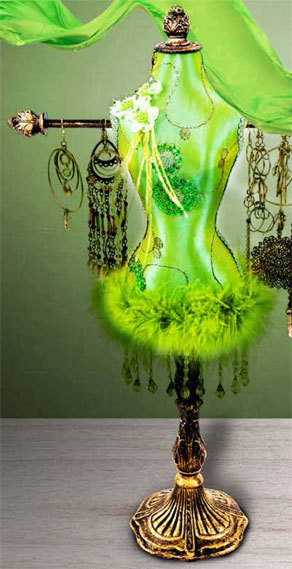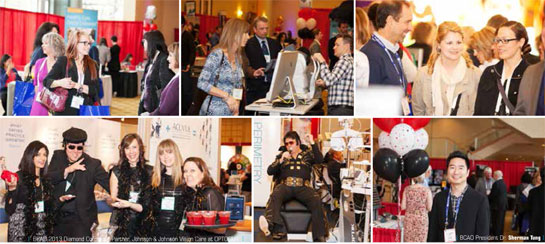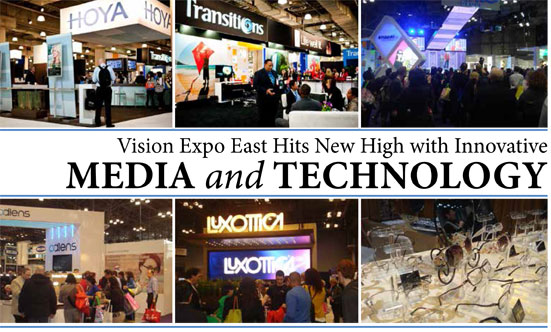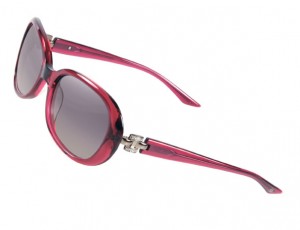By JoAnne Sommers
 Accessories for eyewear just make sense. They combine the benefit of impulse purchases (usually good for both consumer and retailer – just think of the last candy bar or magazine you bought while standing in line at the grocery store) with the allure and seduction of fashion, and the necessity of tender loving care for those expensive lenses.
Accessories for eyewear just make sense. They combine the benefit of impulse purchases (usually good for both consumer and retailer – just think of the last candy bar or magazine you bought while standing in line at the grocery store) with the allure and seduction of fashion, and the necessity of tender loving care for those expensive lenses.
And make no mistake, people get a thrill from wonderful packaging. Apple was on to that some time ago and they’ve made an art of it. Leaving any store with something elegantly packaged and tastefully branded just makes us feel special.
Then there’s the matter of looking good once purchasers get home with their treasures, then head out into the world with their glasses. Will they be wearing matching jewelry? Today, there two companies leading the way with wonderfully hip jewelry that complements eyewear. And when a woman takes her eyeglass case out of her bag, does the case make an impression? Does the cleaning cloth speak taste and refinement while mentioning the name of the optical retail from whence it came?
There are so many good reasons to sell accessories in the optical store. Here are the latest products from Canadian accessory manufacturers and distributors, so you can plan ahead with ways to wow your customers even further.
******
Shilling Optical wants their customers to ‘give away something better,’ and, according to President Howard Shilling, the best cleaning cloth on the market is the microfibre cloth from Microclair. “They use only high-end Japanese textiles with 50 per cent nylon. The high proportion of nylon is what is needed for coated lenses. Other cloths are 80 per cent polyester and because of that, they don’t do the job anywhere near as well. If you sell a product that’s hard to clean, which coated lenses are, how can you not give them the tools to clean them properly?
“Our clients see the value in giving high-end cleaning accessories to customers with their eyeglass purchase,” says Shilling. “Especially when they are custom labeled to reflect the high-end integrity of the business. And the percentage value of this gift is totally in keeping with the cost of the eyewear purchase.”
Eyeglass cases with extra attention to detail are the other key piece of the Shilling offering. “We always present products in a nicer way, so, for example, we have cases available with inserts so the case can be adjusted for the particular frame, ensuring that the frame always fits well within the case.”
With 75 case models available from Shilling, there are bound to be a few that really stand out. One is a novelty case that, when open, looks like a ladies’ high heel shoe. This makes an attractive display item in the store. The reversible case is popular with kids. And the ‘Animal’ case in printed vinyl mimics the animal prints often found on eyeglass temples.
Doc & Associates is a Montreal-based eyewear and accessories importer and distributor. Over the years, founder and President Doris Ouellet has observed a growing and changing accessories market, making the eyewear business increasingly fashion-oriented.
“Accessories are a big part of a worldwide sales phenomenon and, more than ever, non-prescription sunwear and readers are used as fashion accessories to complement a look or add to a garment style. So if retailers are smart, they can increase their sales by understanding this new trend and capitalizing on it. They need to be more creative and start thinking out of the box. Readers are a good example of expanding your offering to include items that customers want and need.”
Doc & Associates offers the Simon Chang readers collection. “He gives reading glasses a fresh look,” says Ouellet. “These are a far cry from traditional reading glasses. All Simon Chang glasses are constructed of the finest handmade optical materials and feature optical-quality and distortion-free lenses. Each pair is designed for fit and comfort.” In addition, non-Rx sunwear under the label of the British pop singing group One Direction is available from Doc & Associates.
Centennial Optical’s Bruno Gismondi is director of marketing for the company’s frames division. Two years ago, he launched custom-printed cloths and cleaning solutions. “In addition to our price point, the main attraction is that we customize everything with whatever the customer wants. One client did a Christmas cartoon image on one side and his hours of operation on the other side, and gave it away as a Christmas promotion to new and existing customers. These things have a long shelf life and people use and appreciate them.”
Also from Centennial are fashion eyeglass cases.Linda Mulford-Hum, director of frames, shops for the latest case trends at international shows like Mido and Silmo. “We try to offer something for everyone,” she explains. “From the basic cases to those designed with fashion trends in mind. This spring and summer, we have polka dots and metallic case covers, and denim is big as well.”
Mulford-Hum is seeing a shift in popular styles toward semi-hard cases. “They’re not as bulky and people prefer that. If you have a case for sunwear and one for glasses, you need a big purse. Collapsible cases are popular, too. And fabric coverings are coming back, which is fun because you have more options in fabrics.”
Personalized cases are also in vogue and make for good, inexpensive advertising, points out Mulford-Hum. “It’s not only the customer who sees the case but so do her friends when she takes it out of her purse.”
Cynthia Shapiro, founder of Europa International and Cinzia Designs, was one of the first to recognize the viability of readers as fashion accessories. Her business acumen led her to see the demographic trend toward people needing readers and she realized that there was nothing attractive on the market, let alone good quality at a reasonable price.
When she began her reader collection, the market only had readers available in black and brown. Now, high-fashion, optical-grade readers and sunglasses for both men and women are available within the flagship Cinzia and Trendies collections. While Cinzia tends to be more conservative, with pieces designed to appeal for many years to come, Trendies offers light-hearted and playful pieces in line with the most current colour trends and fashions.
Shapiro also saw the link between fashionable readers and jewelry, initially using necklaces as a way to hold readers when they weren’t being used. “There’s a very good market for this combination and we started selling them in clothing and accessory boutiques. At first, eyewear retailers couldn’t see it but they came around and now optical sales are strong.”
Today, Shapiro’s collections have expanded to other accessories as well. As she says, “Just as there is an outfit for every occasion, so there is a scarf, necklace, watch, handbag and attractive reader case for every woman with Cinzia readers.”
Shapiro’s collections are distributed in Canada by Cenoco.
McCray Optical Supply has new sports cases for the upcoming season, with loops so customers can attach them to belts, gym bags or purses. “They’re made from semi-hard, lightweight neoprene,” says Operations Manager Shiu-ChiMo.
Metallic and floral print cases match trends in apparel. “We have lovely, bright colours for the ladies for spring and summer,” says Mo.“And although darker colours are consistently popular, it is always easier to find a brighter case in one’s purse.”
McCray also carries a variety of sunglass cases for the larger, deeper sizes of sunwear. “We’ve been getting a lot of requests for these. We have faux snake prints and black patent in leatherette. We even have extra large sizes,” notes Mo.
Cases, cloths, cleaning bottles, and even bags can be personalized. The artwork is done by McCray’s in-house designer with fast turnaround times.
Chains and cords with semi-precious stones and baubles are available from McCray in many different styles. Non-woven, reusable bags are available for product presentation. “These are durable and small,” notes Mo.“If you personalize them, they become excellent advertising because people definitely re-use them.”
A new anti-fog gel cleaner will be introduced soon, in a squeeze bottle sold in a kit with a cloth. And for summer, check out their new floater cords. “These are invaluable for people who spend time on or around the water,” explains Mo.
New readers are also available from McCray, with bright design elements on the temples, while most of the readers have spring hinges.
La LOOP, the New York-based innovator of eyewear-related jewelry, has become an international presence in high-end optical accessories. These are the solution to the everyday problem, ‘where did I put my glasses’, while also being an invention worthy of a presence in New York’s Museum of Modern Art. Their patented technology consists of hinges on either side of every loop. The hinges work with gravity and swivel in every direction, moving with the wearer. The glasses stay securely in the loop, flat against the body and easily accessible. The loop sits at the bottom of these stylish necklaces.
La LOOP materials are of the highest quality. Pearls are real freshwater pearls, shells come from the beaches of New Zealand, leather is from Italy, and the silver is sterling quality. Handmade in the U.S., new collections are released twice a year, designed by founder Elizabeth Faraut and her team. One recent new design is the Le Collier Reader Necklace, which has two +2.0 magnifying lenses. Another new model, the La LOOP Monocle combines fun colors like fuchsia and turquoise of the round crystal monocle with the quality Italian leather of the necklace.
La LOOP is worn by celebrities, including Brad Pitt, Julia Roberts and Heidi Klum, and is sold in stores and specialty boutiques around the world, including Bon Marché in Paris, Harrods in London, Optical Shops of Aspen and Bergdorf Goodman in America.
Ronor International has a new Essentials line. “We cannot imagine a consumer buying eyewear today and not receiving a case,” says General Manager, Accessories Division, Martin Pauzé. “While everyone is offering a case these days, our customers like to offer unexpected extras to their customers: the cloth and cleaner packaged together in a nice bag. Added to expert, personalized service, these extras would definitely differentiate the independent practice from the competition, helping to increase customer loyalty, while promoting the practice.”
A revolutionary new biotechnology-derived cleaner is also available from Ronor International. MULTI CLEAN +, is free of chemicals, including VOCs, and independently certified as safe for AR coatings. “It is the safest cleaner for the environment and perfect for consumers who are sensitive to chemicals, as it is hypoallergenic,” explains Pauzé,
Reading glasses from Ronor International in a wide variety of colours and shapes make the I Need You collection shine, according to Pauzé. The collection features standardized PD (31/31), aspheric lenses with anti-scratch coating, in compliance with CE standards and come with a one-year warrantee against manufacturer defect. “The POP display that fits 24 readers ensures effortless sales!” he adds.
Microclair is one of the leaders in the Canadian optical accessory market, all the more so for manufacturing their products here at home. They have also become leaders in the eco-friendly products field.
“As a socially responsible company, we have replaced all our vinyl packaging with cardboard obtained from sustainable forests,” explains President Leila Fakhouri. “We’ve also created a hard case made from an eco-friendly plastic.”
Of course, the premium microfibre cloth for which Microclair is so well known is also eco-friendly in that it is reusable. “We’re working hard to get the whole product line into environmentally sustainable materials. We got out on the front edge and the response is very encouraging.”
Microclair’s anti-fog treatment, introduced in 2012, is a long-lasting formula and safe for use on all types of lenses. “It is very popular with sports people,” says Fakhouri. “Our promotional program offer includes a matching cloth and a cleaner, personalized in all pantone colours using water-base inks that are safe for the environment. Our bottles are all refillable, giving customers a good reason to come back to your store. Quality and design are our specialty. Our prices are only slightly higher than the competition, and you get amazing packaging and high-quality, Canadian-made goods.”
Hilco was built as a solutions company for the eyecare profession, with innovative tools and safety eyewear that lead the industry, and practice brand-building ideas that are a real focus for its customers, says Canadian Sales Manager Don Coulson. “We recognized that independent ECPs had to be concerned about branding their businesses in light of big box retailers who have massive ad and marketing budgets. What are customers walking out of the store with? If they don’t have a lens care kit for their frames, or something to protect their eyes while playing sports or from UV rays, then the practitioner is not meeting their needs or doing their job. And everything that leaves with that patient is a chance to brand the practice.”
Hilco recently solidified its presence in the branding field by acquiring i-Promotions, a St. Louis-based supplier of eyecare supplies, accessories and promotional products. President Bob Nahmias says, “i-Promotions adds practice identity and logo creation services and expands our product range to printed materials and thousands of promotional products for in-office use or community outreach.”
Coulson defines an accessory as, “anything the patient walks out with that isn’t the optical correction eyewear they came in for. Most patients who need safety eyewear for hobbies or sports don’t necessarily know they need it when they come in for their regular glasses,” he explains. “And if the ECPs have the product and ask the right questions, they will be serving patients better and maximizing revenue opportunities.”
Prisme Optical Group has a beautiful collection of readers. “We had these specially made for us, to serve the practitioner who wants to carry better quality readers,” says President Richard Stortini. “It is our contention that specialty stores should carry quality product to distinguish them from the cheap stuff that is so widely available. The Lecto Color collection reflects this philosophy.”
The Lecto Color collection has readers in both acetate and stainless steel, for men and women. Stortini says, “We have some great shapes and funky colours. Customers love to pick them up as an extra pair for the car, bedside table or purse. The frames are so nice that some people want to put Rx lenses in them.”
Prisme continues to sell over 50 different models of chains, as well as cloths for private labeling. “One of our customers put a painting by her husband on one side of the cloth and her store information on the other,” notes Stortini. “It made for a very impressive take-away gift for her clientele.” He adds that the investment needed to acquire a good selection of quality accessories is actually quite low but that the yield at the end of the year in terms of add-on sales can easily be triple the investment. “Plus, you’re providing your customers with products they want and will value.”
Gifts, upsells, add-ons… however you look at it, the time is now to make sure customers know they can count on you for all their eyewear needs, and then some!
 Brian Paul, OD, considers himself a “picky” patient. That’s why the optometrist at Brantford Medical Centre in Ontario believes in the enhanced vision offered by free-form lenses.
Brian Paul, OD, considers himself a “picky” patient. That’s why the optometrist at Brantford Medical Centre in Ontario believes in the enhanced vision offered by free-form lenses.









